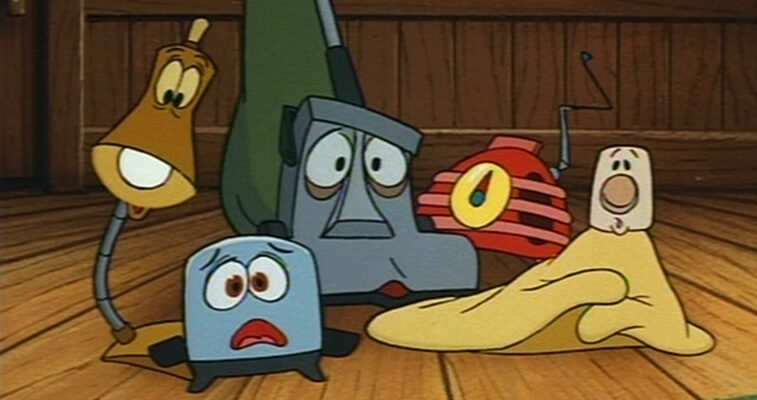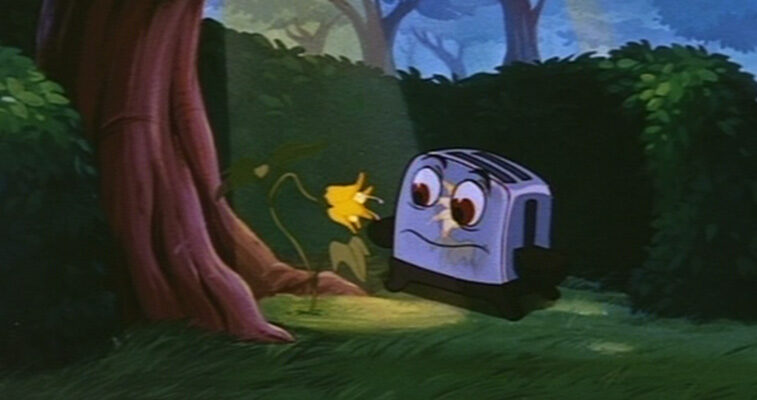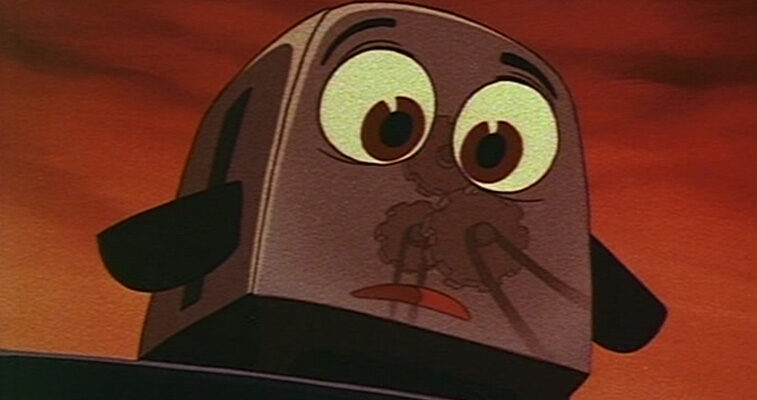[8]
The Brave Little Toaster bares the title of an innocuous children’s cartoon, but there’s more to this gem than may initially meet the eye. First, know that Pixar Animation founder John Lasseter originally pitched this movie as his first computer-animated feature, an honor that later went to the similarly-themed Toy Story. Many of the top talent from The Brave Little Toaster went on to work at Pixar and Disney Animation, including Glen Keane, Joe Ranft (A Bug’s Life), Kirk Wise (Beauty and the Beast), Rob Minkoff (The Lion King), Mark Dindal (The Emperor’s New Groove), and Kevin Lima (A Goofy Movie). So just from the pedigree, you already know this isn’t your typical kiddie flick.
The Brave Little Toaster centers around five outdated appliances who’ve been abandoned in a summer cottage for several years. One day, out of longing to be reunited with ‘the master’ (the kid who used to play with them), they depart into the wilderness in search of the big city. Along the way, these anthropomorphic gadgets learn to stop bickering and bullying each other. They start practicing respect and kindness as they depend on each other for survival on their adventure. Sounds like a great story for kids, right? Now let me tell you why adults should check this movie out.
The Brave Little Toaster deals with mature themes in surreal, deeply moving ways. Yes, I said this cartoon is deeply moving, and I meant it. Let’s start with the fact that the character ‘air conditioner’ (voiced by Saturday Night Live‘s Phil Hartman) can’t go on the journey. Why? Because he’s stuck in a wall, an impairment that makes him jealous and paranoid. When the other characters confront him about his feelings, he becomes enraged and blows a fuse — the human equivalent of an aneurism. This is when The Brave Little Toaster lays down the gauntlet — it’s a movie about empathy, and the air conditioner is the first victim in not being able to cope with feelings. And throughout the rest of the movie, the appliances will struggle with empathy, sharing their feelings and dealing with them. It’s the kind of masterful, dramatic subterfuge upon which Pixar would build its legacy.
The film features dark moments you might find surprising. Toaster (Deanna Oliver) has a nightmare in which he accidentally starts a fire that endangers the master. When the firefighter comes, it’s a clown that opens its fire hose on the electrical appliance. Toaster runs and the water turns into a series of cascading forks. It’s one of the movie’s most surreal moments, but the symbolism conjures all the feelings of guilt you’ll ever need to empathize with a hunk of chrome kitchenware. A storm blows Blanky (a childlike electric blanket voiced by Timothy E. Day) into the tree tops, and Lampy (a snarky desk lamp voiced by Timothy Stack) is struck by lightning while spotlighting for him. Kirby the vacuum cleaner (voiced by Thurl Ravenscroft) accidentally ‘drops’ everyone down a waterfall. Heavy stuff for cartoon characters to deal with.

Discovering empathy, the appliances go from selfish to selfless. Some characters learn it more easily than others. Toaster simply tries it out by letting Blanky snuggle up next to him one night. Lampy calls him out for the random act of kindness, proclaiming it’s ‘weird’. But at least it gets the conversation started. Kirby, the gruffest of the characters, learns it the harder way at the aforementioned waterfall. When everyone else plunges to the water below, Kirby slowly withdraws from the cliff’s edge. You expect he might be guilt-ridden or ashamed. The camera lingers on that empty cliff for a minute, and I imagine Kirby, off camera, quickly learning the pains of true loneliness. A moment later, he suddenly careens over the edge at great speed, plummeting down the waterfall right after the others. To save them, or to die with them — either way, a profound lesson learned. And this isn’t the last time The Brave Little Toaster will deal with the act of self-sacrifice.
While the film’s production values aren’t as polished as classical Disney animation, they’re far better than, say, a Hanna-Barbera cartoon. Highly expressionistic character designs and impressionistic background paintings help compensate. The magic sauce in this movie is David Newman’s large, symphonic score — a dynamic effort that I consider the finest in the composer’s decades-long career. There are four original songs in the movie, but rest easy — three of them are actually entertaining. And there’s also humor, much of which is sure to go right over the heads of the younger viewers. Saturday Night Live alum Jon Lovitz provides many of these moments as the clock radio, butting into tense moments with seemingly non-sequitur lines like, “Why, if only we were all wiener dogs, our problems would be solved.”
And then there’s the flower. If you’ve already seen The Brave Little Toaster, I’m sure you already know what I’m talking about — one of the saddest moments in animated movie history, right there with the death of Bambi’s mother. This moment beautifully encapsulates everything wonderful about the movie — it’s meaning and it’s way of expressing it. Toaster is fleeing a meadow where several woodland creatures are obsessed with their reflections in his chrome surface. Overwhelmed by the attention, Toaster hides in the woods. He finds a lone flower next to a tree, barricaded by bushes, slouched in a single beam of sunlight. When the flower sees its reflection in Toaster, it embraces him. Toaster tries to explain that it’s just a reflection, but the flower doesn’t let go. Toaster runs away, but peers back. The flower slouches… and one of its petals falls to the ground.
Now, I’m just going to ask some questions in closing: Did the flower really only see its reflection, or did it see Toaster for who Toaster really is? Does it matter? Why was toaster scared of the flower’s embrace? I’ve seen The Brave Little Toaster a handful of times now, and I never stop thinking about that flower scene and the nature of empathy.
Directed by Jerry Rees.


